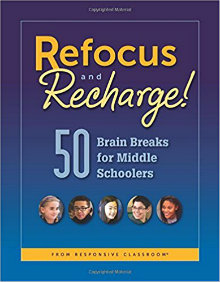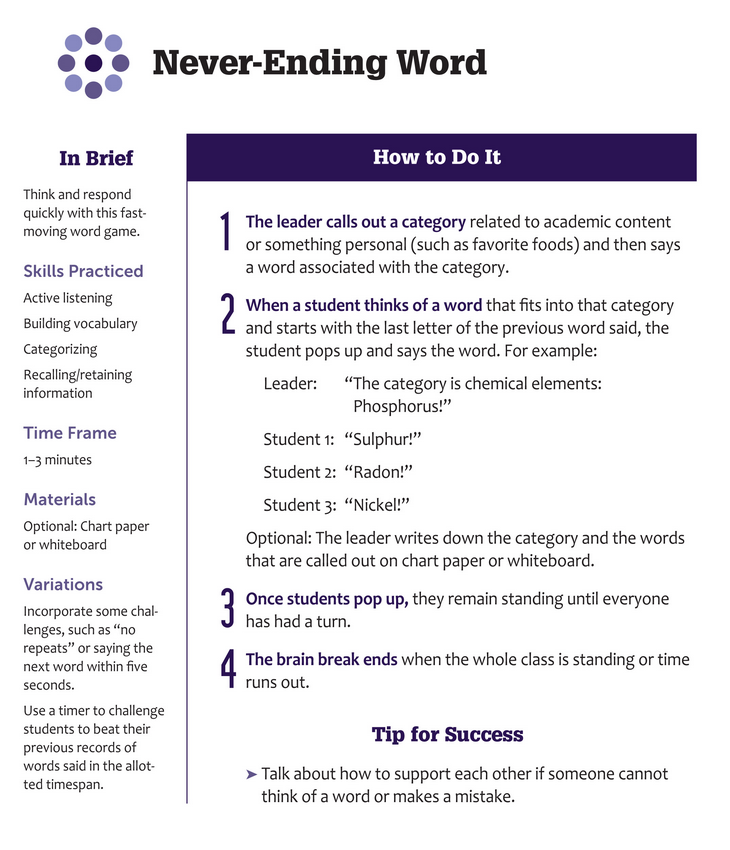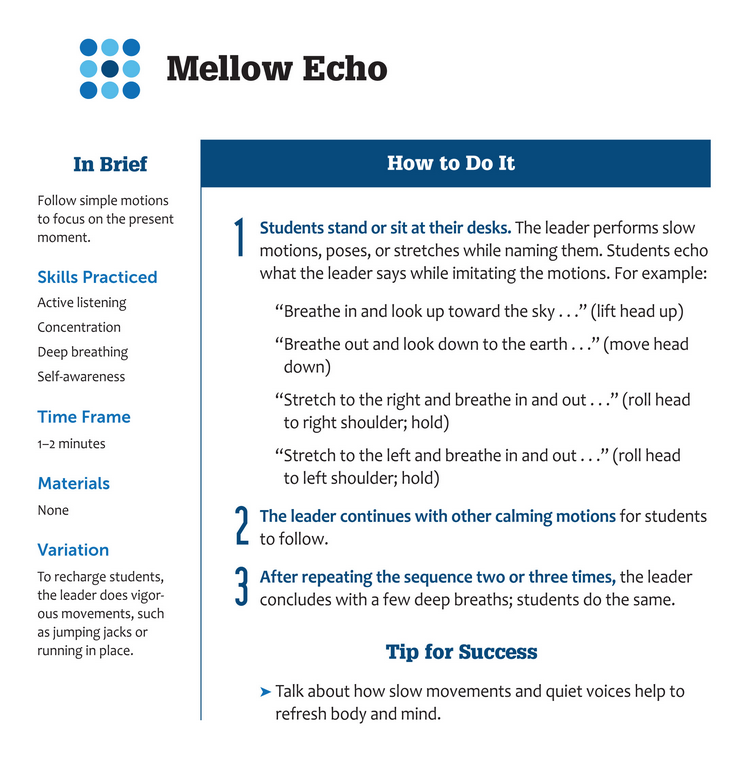50 Brain Breaks for Middle Schoolers
Refocus and Recharge! 50 Brain Breaks for Middle Schoolers
(Responsive Classroom, 2016 – Learn more)

During Morning Meeting several years ago, I posed the question to my fourth grade class: “How can we make our transition time between subjects smoother?”
At that time, I was frustrated with the transition between subjects. The students were wonderful. The class was respectful, caring, ready to learn, but when we had to change from Math Workshop to Readers Workshop, it was taking longer than I expected due to students chatting…and chatting…and chatting.

It made sense to me. Yes, my students could sit where they wanted to during workshop. Yes, they had a chance to turn and talk. Yes, they worked together on projects and activities. This student was right. They needed a break.
When I first heard about using brain breaks in my classroom, I was intrigued. The research was there and it was powerful. As I read more about brain breaks and watched some online videos, I reflected on my experience in college studying for exams. I don’t know about you, but after studying for what seemed forever, my brain felt as it was about to burst.
After sitting and studying for what felt like forever, l thought, “I am not remembering what I am reading. I need a break.” Taking a break gave my mind a chance to process what I was studying and gave it a chance to relax.
Think back. It wasn’t a luxury to do that. It was a necessity. Our brain is not built to be a robot, but is designed to work and rest.
Just the brain-breaks resource I need
Responsive Classrooms’ recently published book, Refocus and Recharge! 50 Brain Breaks for Middle Schoolers, tells it “the way it is”:
Middle schoolers are at an age when the need frequent opportunity to pause, move and interact to recharge themselves and refocus their energies.” (p. 1)
Honestly, I have used the Internet to find videos of “brain breaks,” and they are successful in giving my students a chance to recharge and refocus. I have also noted that some of the students are reluctant to participate in the online brain breaks and feel uncomfortable. They may view them as “silly or too babyish.” In addition, even though my favorites are bookmarked and starred, by the time I load the videos I have lost valuable teaching time.
Responsive Classroom’s spiral bound, 99-page directory of brain breaks is exactly what my students (and I) need. There are 50 brain breaks that give the students a chance to mentally rest their brain by redirecting their mind to movements that give them an opportunity to refocus, and release energy and stress. Quite frankly, it gives them a chance to breathe!
So, what is a brain break?
“Brain breaks are quick, whole-class activities that give students a mental and physical break from rigorous academics. Student can stand up, stretch and move.” (p.1) Whether calming or energizing, brain breaks:
- Refresh the brain and body so students feel alert
- Give students a safe and structured way to connect with peers and teachers
- Refocus students’ attention so they’re ready for more (and more productive) learning.
Reflective brain breaks, such as breathing exercises, also have benefits backed by research. Many of the calming brain breaks in the book, such as the breathing exercises and guided imagery, teach students ways to handle stressful situations.
Quick and easy to use
As with all Responsive Classroom books, the book is definitely written with the busy teacher in mind. There is an easy-to-use chart listing each activity along with a designation of whether it is to refocus or recharge along with a simple explanation and page number.


Linda Biondi is a fourth grade teacher at Sharon Elementary School in Robbinsville, NJ and a long-time Morning Meeting practitioner. She’s also the recipient of several educational grants, a Teacher Consultant with the National Writing Project, and a participant on the NJ Department of Education Teacher Advisory Panel and with ECET2 Celebrate Teaching.



































As you noticed among your fourth grade students, it is a common phenomenon for people to lose focus after concentrating on a mentally taxing activity for an extended period of time. This phenomenon has been scientifically explained and proven. Dr. Alejandro Lleras, a psychology professor at the University of Illinois, compares this gradual decrease in attention to the gradual loss of sensory perception of a stimulus after prolonged exposure to it. As Lleras explains, our bodies habituate, or gradually become used to, a stimulus after prolonged exposure, leading us to stop meaningfully responding to the stimulus. Our brains exhibit this same phenomenon in regards to gradual loss of attention: when we are exposed to the same mentally challenging activity—for example, math problems—for an extended period of time, our brains stop responding to the activity in a meaningful way, causing our attention to drift to novel subjects. In order to keep students’ attention focused on classroom activities, the activities must remain attention-grabbing and novel. This is where the idea of taking breaks comes in. When students are given short breaks that briefly and explicitly direct their attention elsewhere, students break their habituation to the academic task they’ve been concentrating on. Consequently, when they return to the task after the break, the task becomes perceptually salient again. This leads to higher attention on the task at hand and more significant learning.
Lleras conducted a study that proved this benefit of taking short breaks to increase learning and performance. In Lleras’ experiment, there were three groups of subjects preforming a mentally strenuous, computerized task under varying conditions. Members of the first group had to complete the hour-long task with no breaks. Members of the second group were asked to perform a separate memory activity twice over the course of the computerized task, in which they were forced to briefly divert their attention from the computerized task. Members of the third group were shown random numbers in the middle of the task, but were told to ignore them. The second group, which intermittently performed the memory activity, was the only group that got a significant break from the hour-long task and the only group whose performance on the task did not worsen over the hour. Lleras said the second group’s performance “seemed to be unimpaired by time” while the other groups’ performances were “so clearly dropping off” over the course of the hour. This study backs up your observation that your students became “re-energized, re-engaged, and ready to learn” after they were given short breaks.
As you’ve written about in your blog post, mental breaks are beneficial for increased learning and retention of information. While many teachers may be apprehensive about taking breaks during the school day, short breaks are proven to maximize student learning and are worth the time, as Llera’s study exemplifies. Taking breaks can, and should, be applied to classes in all subject areas, because focusing attention on any subject for an extensive period of time can lead to habituation and decreased retention of information. It seems to me that taking breaks in subject areas such as math, in which students are expected to complete repetitive problems, would be most beneficial because attention easily habituates to that type of task. All in all, scientific research supports your claim that teachers should utilize short breaks to maximize learning in their classrooms.
Works Cited:
Nauert PhD, R. (2015). Taking Breaks Found to Improve Attention. Psych Central. Retrieved on March 17, 2017, from https://psychcentral.com/news/2011/02/09/taking-breaks-found-to-improve-attention/23329.html